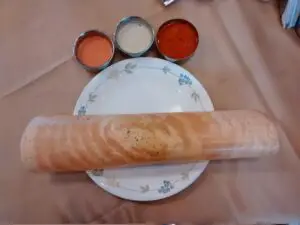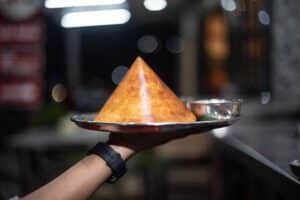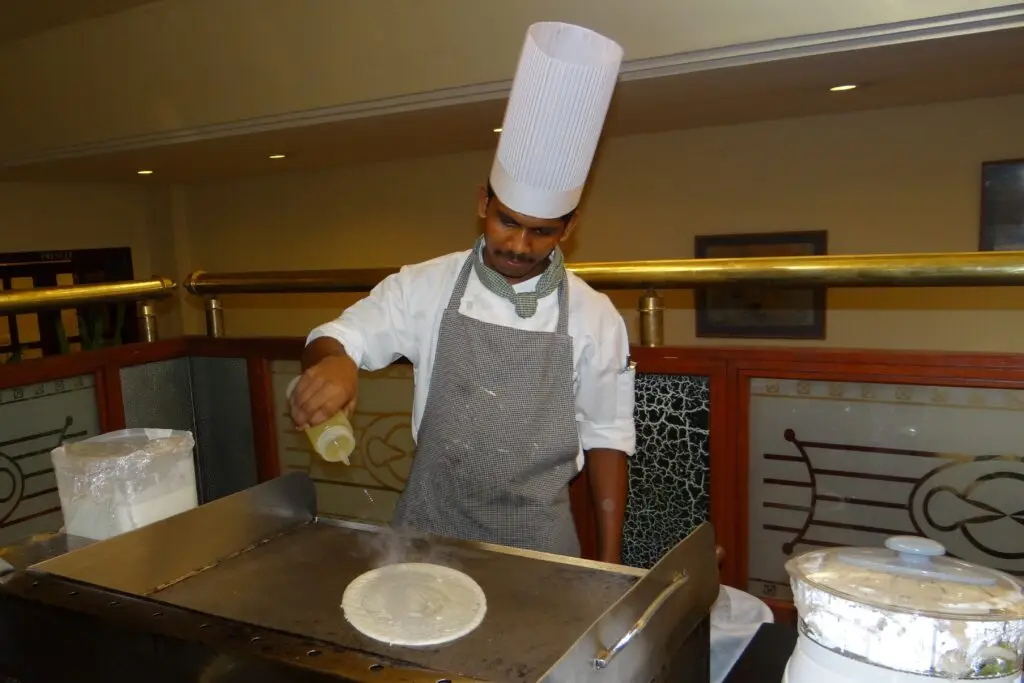Dosa, a beloved dish from South India, has gained fans across the globe for its unique flavor and versatility. This thin, crispy pancake is not only tasty but also healthy. Whether you are an experienced cook or a beginner, learning to make dosa recipe is fun and easy. In this blog, we’ll guide you step-by-step so you can make delicious dosa at home.



What is Dosa?
Dosa is a delicate and crispy pancake crafted from fermented rice and urad dal (black gram), offering a perfect blend of taste and texture. It is usually served with sambar (a vegetable stew) and coconut chutney. You can make plain dosa or stuff it with a potato filling to create masala dosa. You can also try other fillings to make it your own.
Ingredients Needed to Make Dosa Recipe
Before you start, get these ingredients ready:
For the Batter:
- 2 cups rice (dosa rice is best)
- 1/2 cup urad dal (split black gram)
- 1/4 teaspoon fenugreek seeds (optional, for better flavour)
- Water, as needed
- Salt, to taste
For Cooking:
- Oil or ghee, for greasing the pan

Step-by-Step Process to Make Dosa Recipe
Step 1: Soak the Ingredients
Rinse the rice and urad dal well. Add fenugreek seeds and soak everything in water for 4-6 hours. Soaking makes them soft and ready for blending.
Step 2: Grind the Batter
Drain the water. Grind the rice and dal separately into a smooth paste using a blender. Mix both pastes in a big bowl. Add water to get a batter that’s thick but can still flow easily. The batter should stick to a spoon but not be too thick.
Step 3: Let the Batter Ferment
Cover the bowl and leave it in a warm place for 8-12 hours to ferment. The batter will rise and get a slightly sour taste. If you live in a cold place, you can keep it in an oven with the light on.
Step 4: Add Salt
Once the batter is fermented, gently mix in salt. Don’t stir too much as it might make the batter lose air.
Step 5: Heat the Pan
Heat a flat pan (dosa tawa) on medium heat. Sprinkle a little water on the pan to check if it’s hot. When the water droplets dance and evaporate instantly, your pan is perfectly heated.
Step 6: Spread the Batter
Spoon a ladleful of batter onto the center of the pan with care. Spread it in a circular motion using the back of the ladle to make a thin layer. Don’t worry if your first few dosas are not perfect—you’ll get better with practice.
Step 7: Add Oil
Gently sprinkle a few drops of oil or ghee along the edges of the dosa to enhance its crispiness. Let it cook for 2-3 minutes until the edges lift and the bottom is golden brown.
Step 8: Serve
Carefully fold the dosa and plate it while hot, pairing it with fresh chutney and flavorful sambar.
Simple Tips to Make Dosa Recipe Perfect
- Use the Right Rice and Dal: Dosa rice works best. Regular rice may not give the same texture.
- Check the Batter: The batter should not be too thick or too runny.
- Season the Pan: If using a cast-iron pan, make sure it’s well-seasoned to avoid sticking.
- Control the Heat: The pan should be hot but not too hot. Adjust the heat as needed.
- Allow Proper Fermentation: Fermented batter gives the best flavor and texture.
Easy Variations of Dosa
- Masala Dosa: Add a spiced potato filling.
- Rava Dosa: Made with semolina, no fermentation needed.
- Neer Dosa: A light dosa made with rice flour and water.
- Set Dosa: Soft and fluffy, served in small stacks.
- Paneer Dosa: Filled with spiced paneer for a twist.
Health Benefits of Dosa
Dosa is a tasty and healthy option:
- Energy Boost: Rice provides carbohydrates for energy.
- Low Fat: With little oil, dosa is a low-fat meal.
- Good Protein Source: Urad dal adds protein, great for vegetarians.
- Good for Digestion: Fermented batter is great for your gut.
Common Mistakes to Avoid When You Make Dosa Recipe
- Skipping Fermentation: Without fermentation, dosa won’t taste or look right.
- Wrong Batter Consistency: If too thick, dosa won’t spread; if too thin, it will tear.
- Not Enough Heat: A lukewarm pan will make dosa stick.
- Using Too Much Oil: Use just a few drops for crispiness.
Conclusion
Making dosa at home is easy and rewarding. Follow these simple steps, and you’ll enjoy crispy, delicious dosas every time. Give it a try today and savour the authentic flavors of South India right at your table!
If You Want More Recipes Read Click Here
What is a Dosa?
A dosa is a traditional South Indian crepe made from a fermented batter of rice and urad dal (split black gram). It is thin, crispy, and typically served with a variety of chutneys and sambar (a spicy lentil soup).
Is Dosa gluten-free?
Yes, dosa is naturally gluten-free, as it is made from rice and lentils. However, if you have a severe gluten intolerance, be sure to check for any cross-contamination or added ingredients that may contain gluten.
Can I make dosa at home?
Yes, you can easily make dosa at home with a few ingredients. Pre-made dosa batter is also available in stores for convenience.
Is dosa healthy?
Dosa is a healthy option as it is made from natural ingredients like rice, lentils, and fermented grains. It is also low in calories, depending on the fillings and toppings. For a healthier version, avoid excessive use of oil or ghee.
Can I customize my dosa with fillings or toppings?
Yes, many restaurants offer various fillings like mashed potatoes, cheese, or vegetables, along with different toppings such as chutneys or curries. You can ask for specific additions when ordering.
How can I make dosa crispier?
To make your dosa crispy, ensure your pan is hot before pouring the batter, and spread it thinly. To achieve a crispy texture, lightly brush the dosa with oil or ghee while cooking.
u003cstrongu003eCan I freeze dosa batter?u003c/strongu003e
Yes, you can freeze dosa batter for up to 2-3 weeks. Simply let the batter fully defrost before using it for the best results.